A Digital-Simulation Model for a Full-Polarized Microwave Radiometer System and Its Calibration
Abstract
:1. Introduction
2. Full-Polarized Radiometer and Its Calibration
2.1. Digital-Correlation Full-Polarized Radiometer
2.2. Compact Passive Microwave Calibration Target (CPCT)
3. Simulation Model
3.1. Input Signal Models
3.1.1. Hot and Cold Calibration Target Signals
3.1.2. CPCT Signals
3.1.3. Ideal Full-Polarized Signals
3.2. Full-Polarized Radiometer Mode
3.2.1. RF Front-End Model
3.2.2. Digital Correlator Model
4. Results
4.1. Simulation Results
4.1.1. Output Signals
4.1.2. Calibration Result
4.2. Validation
4.2.1. Sensitivity
4.2.2. Linearity
4.2.3. Calibration Residual Error
4.3. Application Examples
4.3.1. Analysis of Gain Imbalance
4.3.2. Analysis of Quantization Error
5. Conclusions
Author Contributions
Funding
Institutional Review Board Statement
Informed Consent Statement
Data Availability Statement
Acknowledgments
Conflicts of Interest
References
- Germain, K.; Gaiser, P.W.; Poe, G. The WindSat calibration/validation plan and early results. In Proceedings of the MTS/IEEE Conference on Celebrating the Past—Teaming Toward the Future, San Diego, CA, USA, 22–26 September 2003. [Google Scholar]
- Gaiser, P.W.; Germain, K.; Twarog, E.M.; Poe, G.A.; Purdy, W.; Richardson, D.; Grossman, W.; Jones, W.L.; Spencer, D.; Golba, G.; et al. The WindSat spaceborne polarimetric microwave radiometer: Sensor description and early orbit performance. IEEE Trans. Geosci. Remote Sens. 2004, 42, 2347–2361. [Google Scholar] [CrossRef]
- Shi, J.; Dong, X.; Zhao, T.; Du, J.; Jiang, L.; Du, Y.; Liu, H.; Wang, Z.; Ji, D.; Xiong, C. WCOM: The science scenario and objectives of a global water cycle observation mission. In Proceedings of the IEEE Geoscience and Remote Sensing Symposium, Quebec City, QC, Canada, 13–18 July 2014; pp. 3646–3649. [Google Scholar]
- Wang, A.; Li, A.; Liu, A.; Lu, A.; Zhao, A.; Zhang, A.; Zhang, A.; Yin, A.; Li, A.; Dong, A.; et al. Polarimetric microwave imager (PMI) for global water cycle observation mission (WCOM). In Proceedings of the IEEE International Geoscience and Remote Sensing Symposium, Beijing, China, 10–15 July 2016; pp. 3458–3461. [Google Scholar]
- Wang, Z.; Liu, J.; Lu, H.; Zheng, W.; Wang, X.; Li, B. A digital correlation full-polarimetric microwave radiometer design and calibration. In Proceedings of the IEEE International Geoscience and Remote Sensing Symposium, Munich, Germany, 22–27 July 2012; pp. 4688–4690. [Google Scholar]
- Lim, B.H.; Ruf, C.S. Calibration of a Fully Polarimetric Microwave Radiometer Using a Digital Polarimeric Noise Source. In Proceedings of the IEEE International Symposium on Geoscience and Remote Sensing, Denver, CO, USA, 31 July–4 August 2006; pp. 3992–3995. [Google Scholar]
- Gasiewski, A.J.; Kunkee, D.K. Calibration and applications of polarization-correlating radiometers. IEEE Trans. Microw. Theory Tech. 1993, 41, 767–773. [Google Scholar] [CrossRef]
- Kim, S.H.; Moon, N.W.; Kim, Y.H. Analysys and verification of calibration methods for fully polarimetric W-band radiometer. In Proceedings of the International Symposium on Intelligent Signal Processing and Communication Systems, Honolulu, HI, USA, 25–30 July 2010; pp. 562–565. [Google Scholar]
- Lahtinen, J.; Gasiewski, A.J.; Klein, M.; Corbella, I.S. A calibration method for fully polarimetric microwave radiometers. IEEE Trans. Geosci. Remote Sens. 2003, 41, 588–602. [Google Scholar] [CrossRef]
- Lahtinen, J.; Tauriainen, S.; Hallikainen, M. HUT fully polarimetric radiometer system. In Proceedings of the IEEE International Geoscience and Remote Sensing Symposium, Sydney, Australia, 9–13 July 2001; pp. 360–362. [Google Scholar]
- Lahtinen, J.; Hallikainen, M.T. HUT fully polarimetric calibration standard for microwave radiometry. IEEE Trans. Geosci. Remote Sens. 2003, 41, 603–611. [Google Scholar] [CrossRef]
- Wang, Z.; Liu, J.; Li, B.; Lu, H.; Li, J. A compact passive microwave calibration target for full-polarized radiometer. In Proceedings of the Progress in Electromagnetics Research Symposium—Fall, Singapore, 19–22 November 2017; pp. 2977–2980. [Google Scholar]
- Chen, Y.; Zhang, Y.; Yong, F. Simulation model of the wideband total power radiometer. In Proceedings of the International Symposium on Intelligent Signal Processing and Communication Systems, Chengdu, China, 6–8 December 2010; pp. 1–4. [Google Scholar]
- Zonca, A.; Roucaries, B.; Williams, B.; Rubin, I.; D’Arcangelo, O.; Meinhold, P.; Lubin, P.; Franceschet, C.; Jahn, S.; Mennella, A.; et al. Modeling the frequency response of microwave radiometers with QUCS. J. Instrum. 2010, 5, T12001. [Google Scholar] [CrossRef]
- Burrage, D.M.; Goodberlet, M.A.; Heron, M.L. Simulating passive microwave radiometer designs using Simulink. Simul-Trans. Soc. Model Simul. Int. 2002, 78, 36–55. [Google Scholar] [CrossRef] [Green Version]
- Kaisti, M.; Altti, M.; Torsti, P. Radiometric Resolution Analysis and a Simulation Model. Remote Sens. 2016, 8, 85. [Google Scholar] [CrossRef] [Green Version]
- Duan, Y.; Wang, Z.; Xiao, Y.; Wang, W. Simulating Radiometric Resolution of Microwave Humidity and Temperature Sounder Onboard the FY-3D Satellite. IEEE Trans. Instrum. Meas. 2020, 69, 6582–6594. [Google Scholar] [CrossRef]
- Duan, Y.; Wang, Z.; Xu, H.; Wang, W. Simulation of the Spectrum Response for the THz Atmosphere Limb Sounder (TALIS). Sensors 2020, 20, 498. [Google Scholar] [CrossRef] [PubMed] [Green Version]
- Li, B. Research on a New Type of Full-polarized Microwave Radiometer Calibration Source and Its Calibration Method. Doctoral Dissertation, National Space Science Center, Chinese Academy of Sciences, Beijing, China, 2017; pp. 15–26. [Google Scholar]
- Lu, H. Design, Calibration and Error Analysis of Digital-Correlation Fully Polarimetric Microwave Radiometer. Doctoral Dissertation, National Space Science Center, Chinese Academy of Sciences, Beijing, China, 2012; pp. 10–14. [Google Scholar]
- Peng, J.; Ruf, C.S. Covariance Statistics of Fully Polarimetric Brightness Temperature Measurements. IEEE Geosci. Remote Sens. Lett. 2010, 7, 460–463. [Google Scholar] [CrossRef]
- Piepmeier, J.R.; Gasiewski, A.J. Digital correlation microwave polarimetry: Analysis and demonstration. IEEE Trans. Geosci. Remote Sens. 2001, 39, 2392–2410. [Google Scholar] [CrossRef]
- Hagen, J.B.; Farley, D.T. Digital-correlation techniques in radio science. Radio Sci. 1973, 8, 775–784. [Google Scholar] [CrossRef]
- Kim, S.H.; Moon, N.W.; Kim, Y.H. System design of W-band fully polarimetric radiometer for target identification. In Proceedings of the IEEE International Geoscience and Remote Sensing Symposium, Honolulu, HI, USA, 25–30 July 2010; pp. 542–545. [Google Scholar]
- Duan, Y. Research on Simulation of Signal Transmission Model and Indicators of Microwave Radiometer System. Doctoral Dissertation, National Space Science Center, Chinese Academy of Sciences, Beijing, China, 2021; pp. 29–31. [Google Scholar]
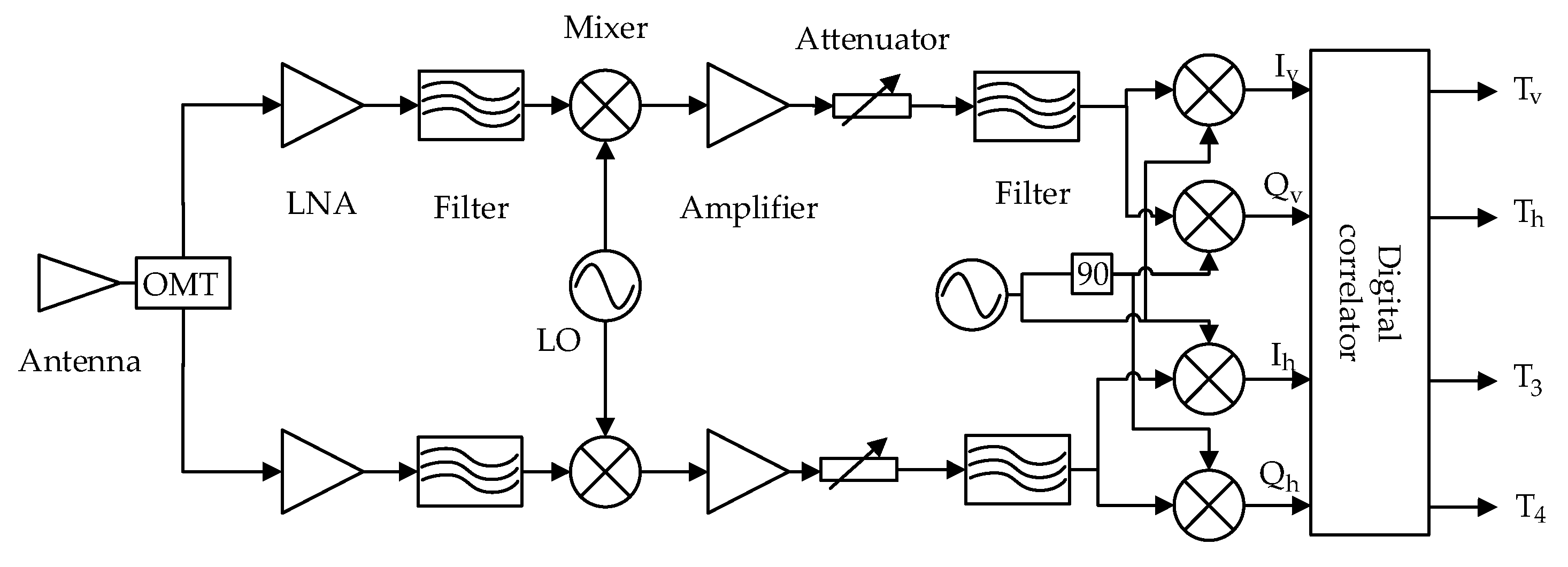
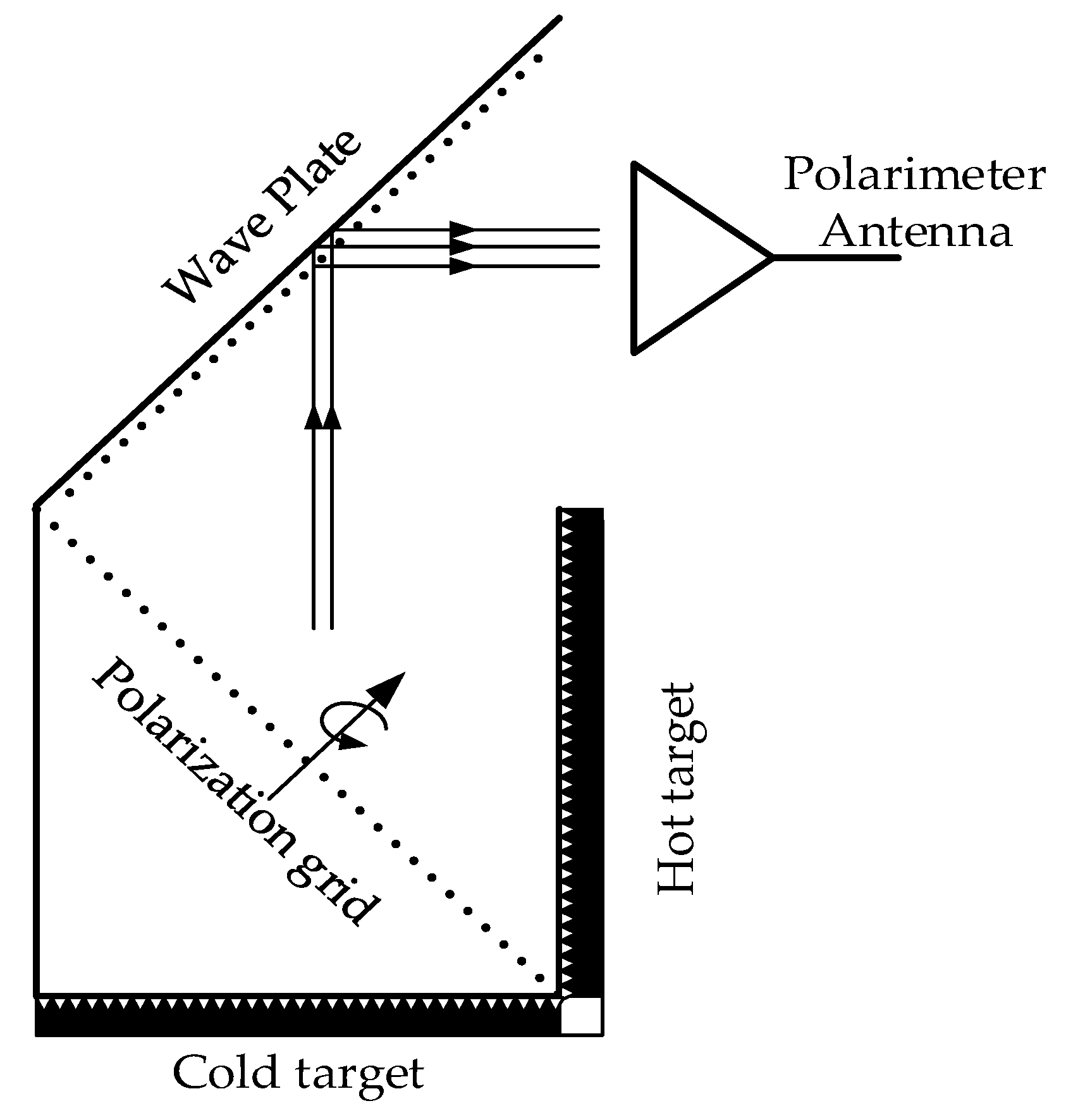
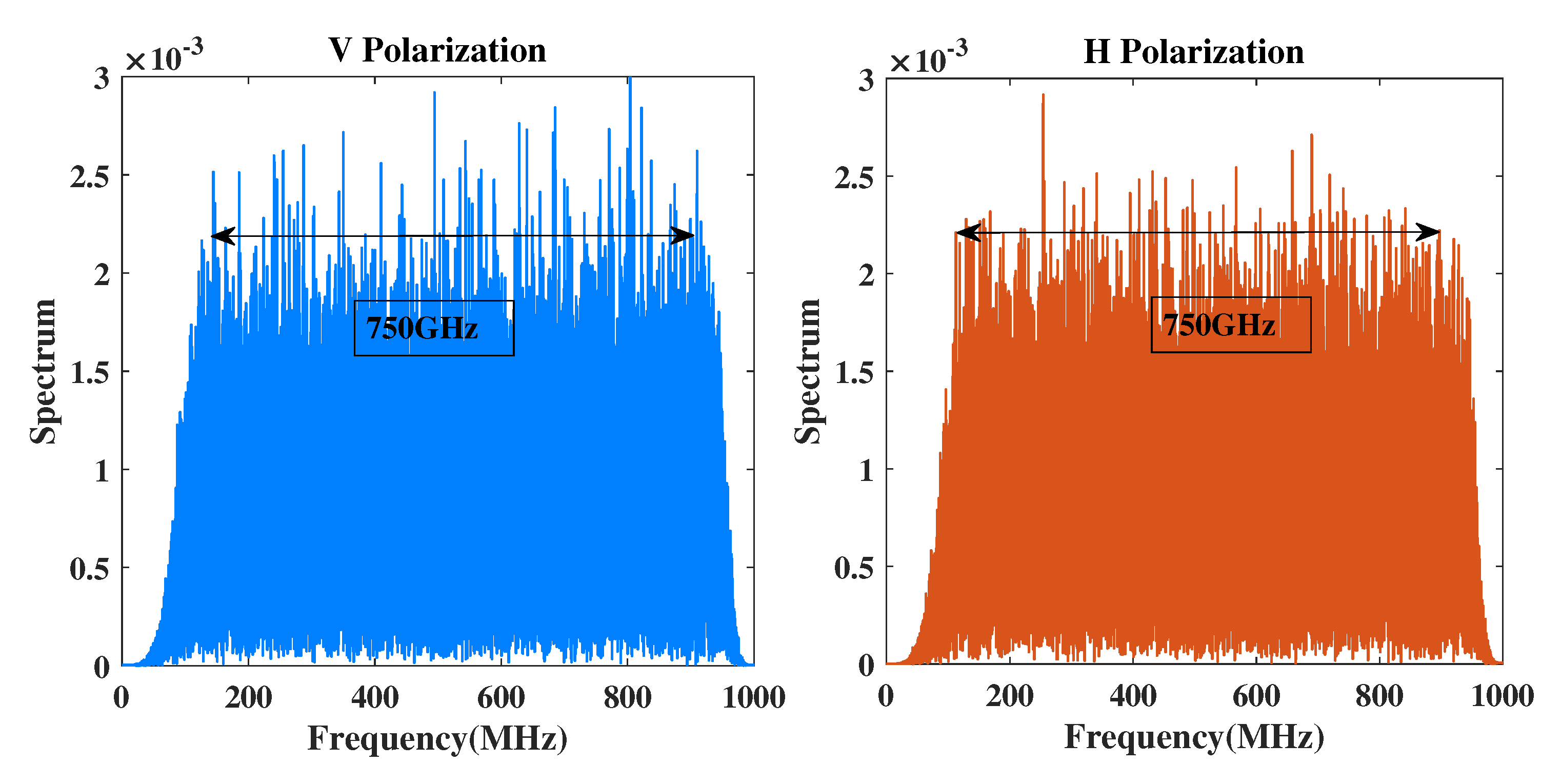
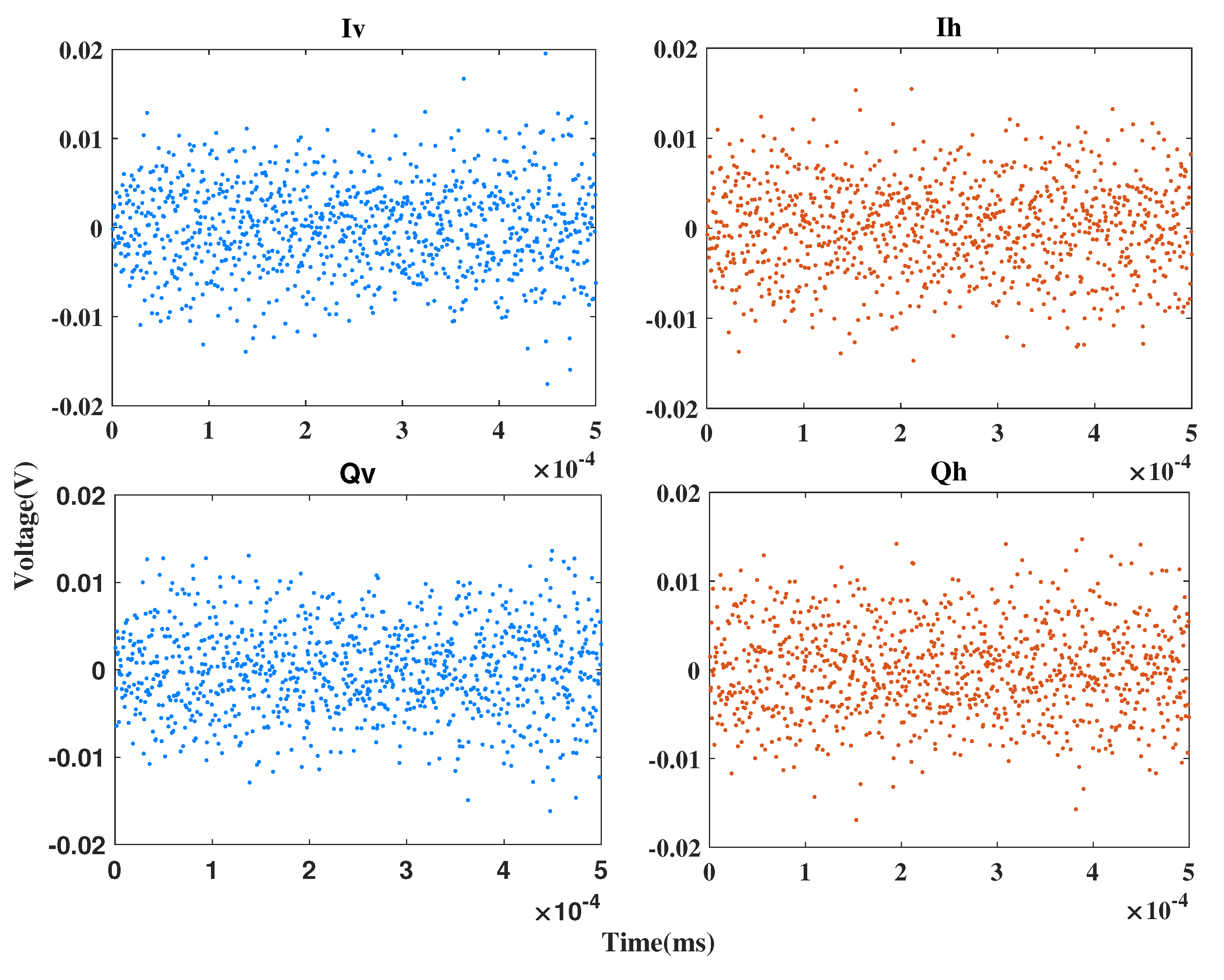
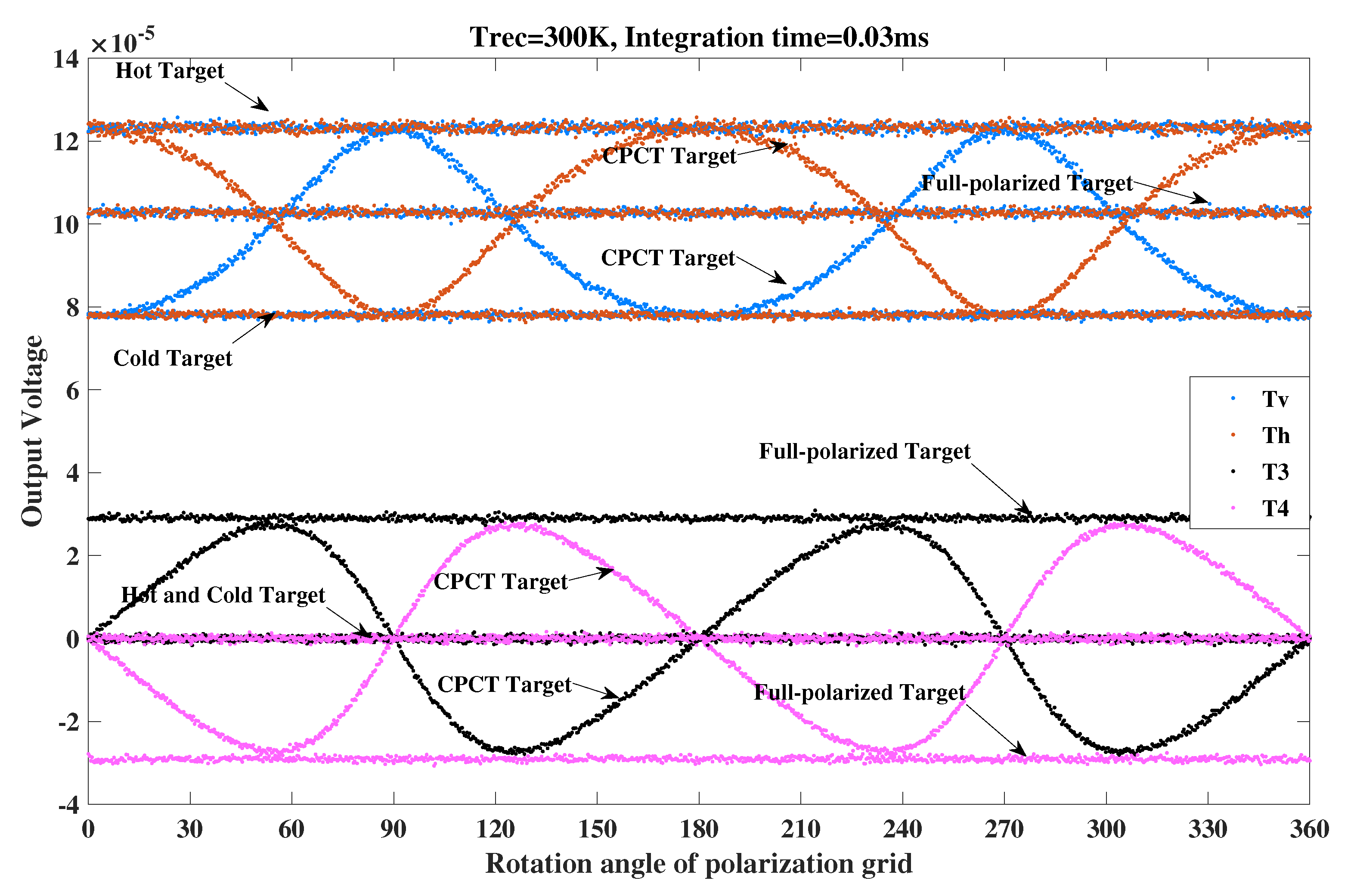
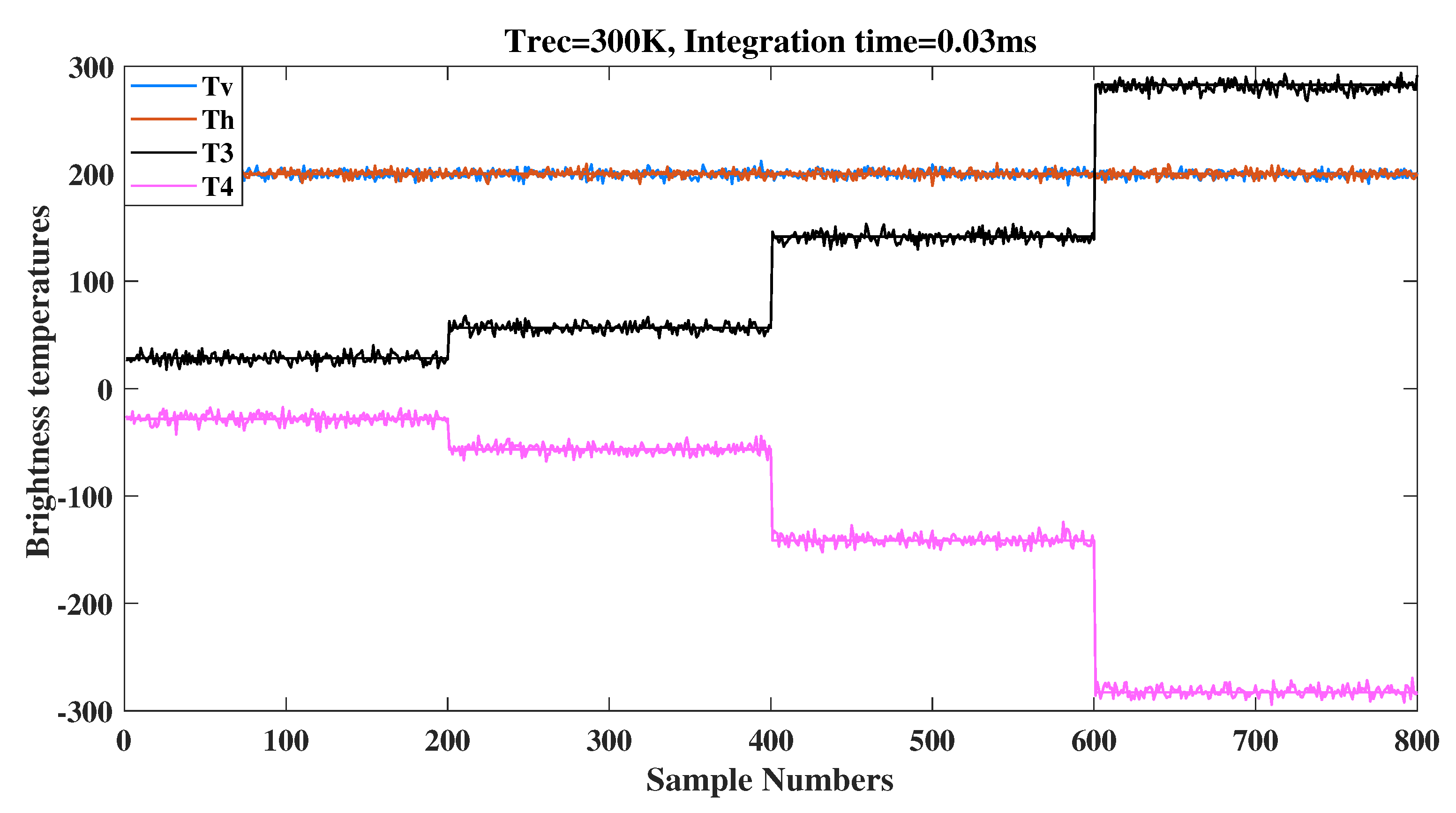
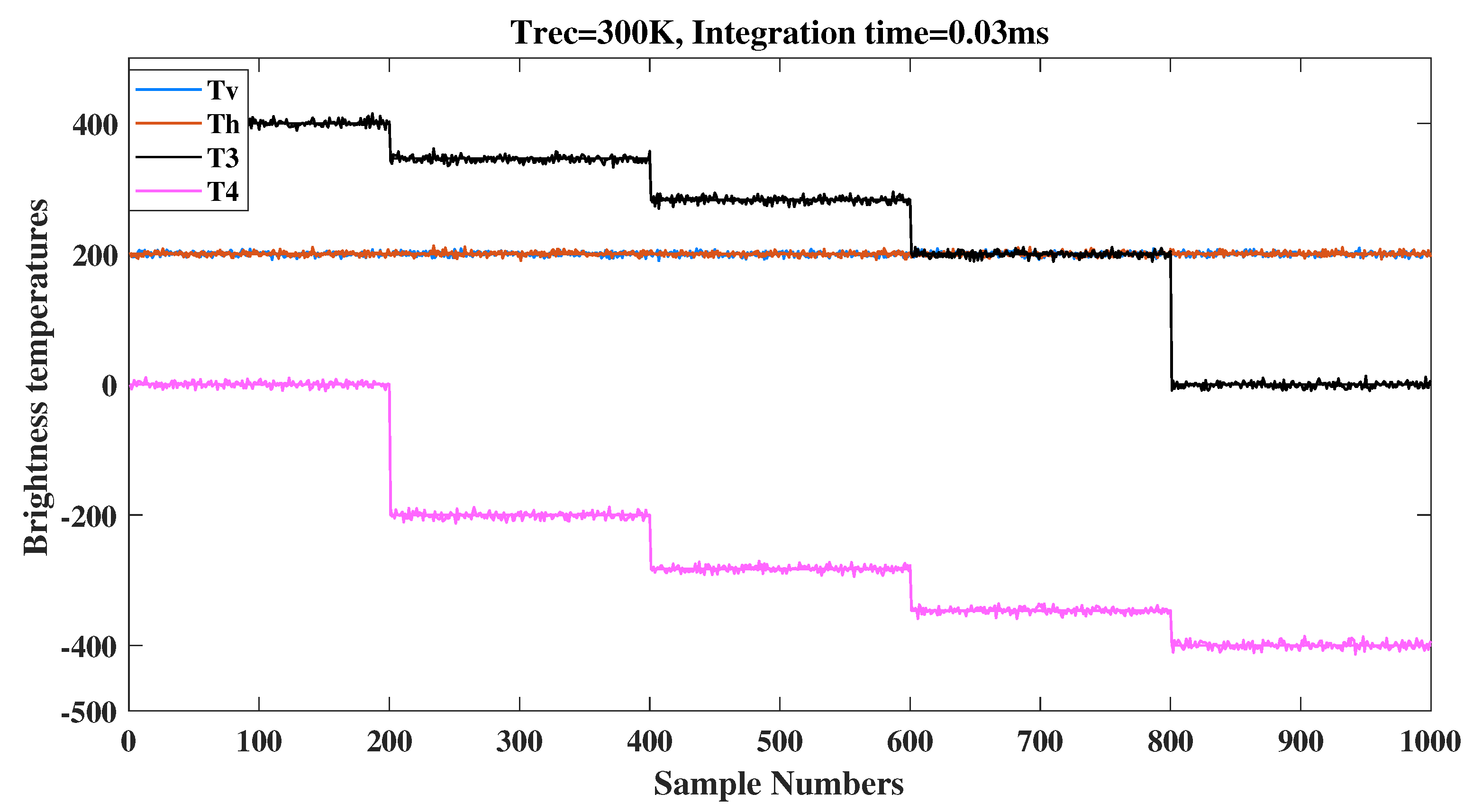

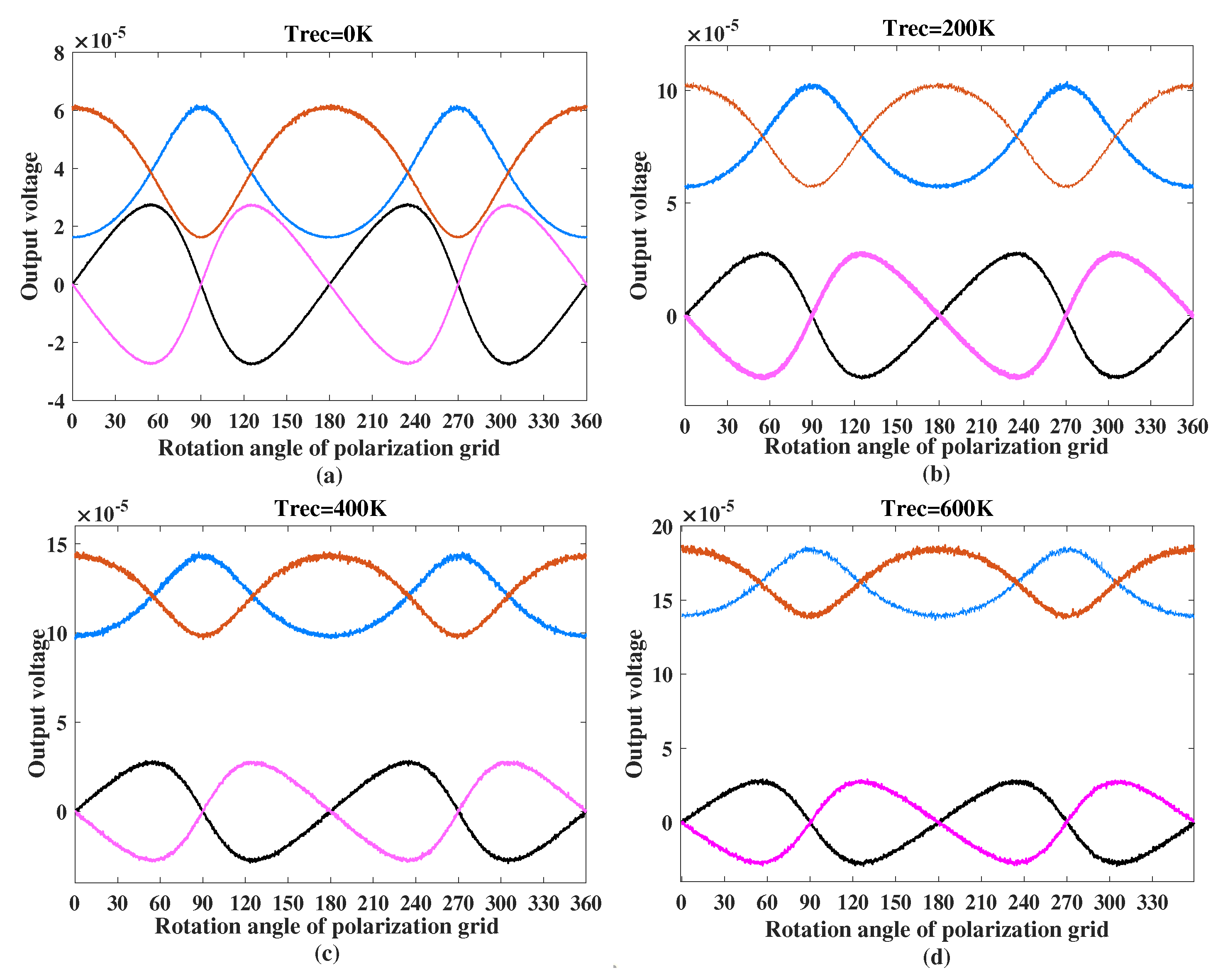
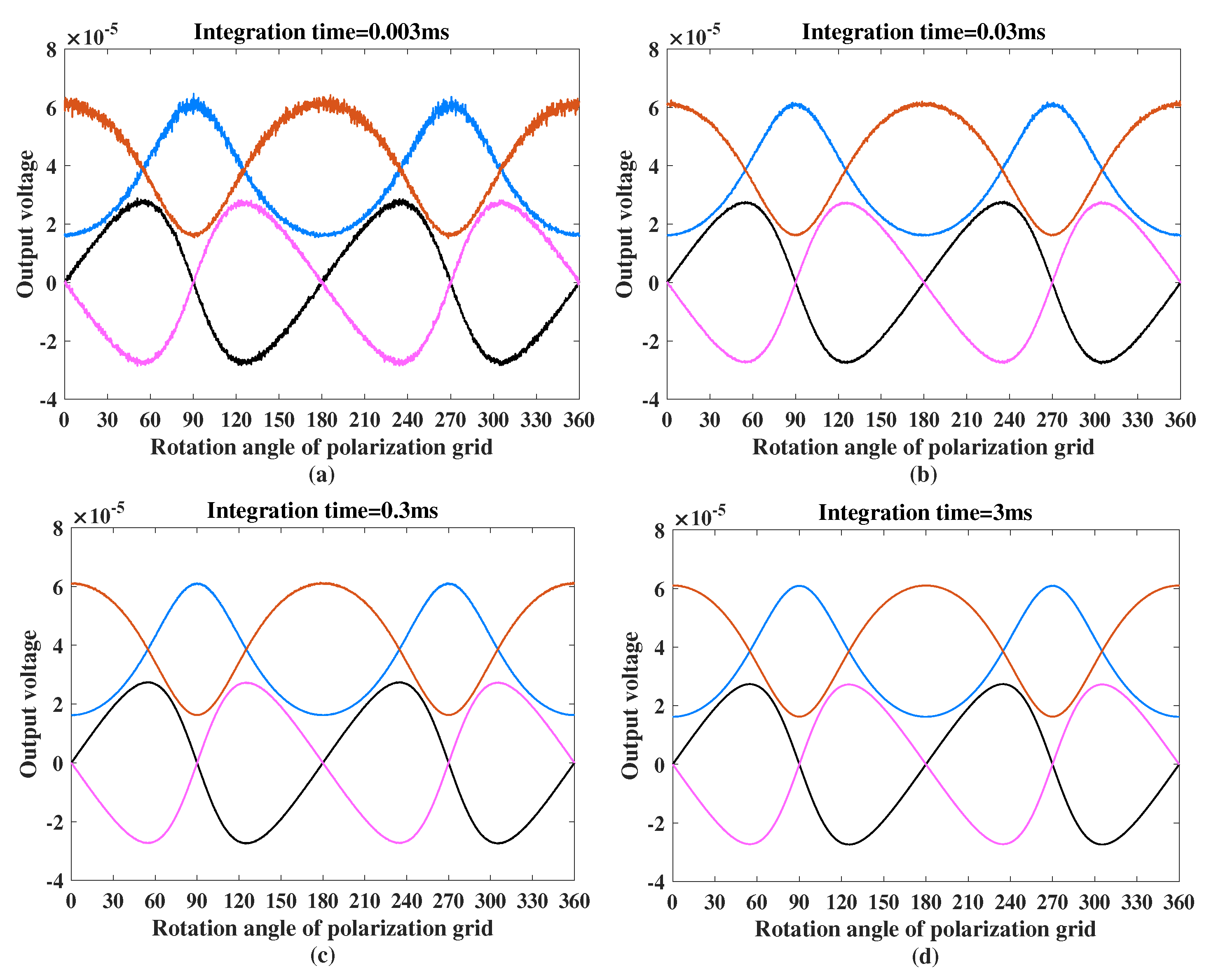
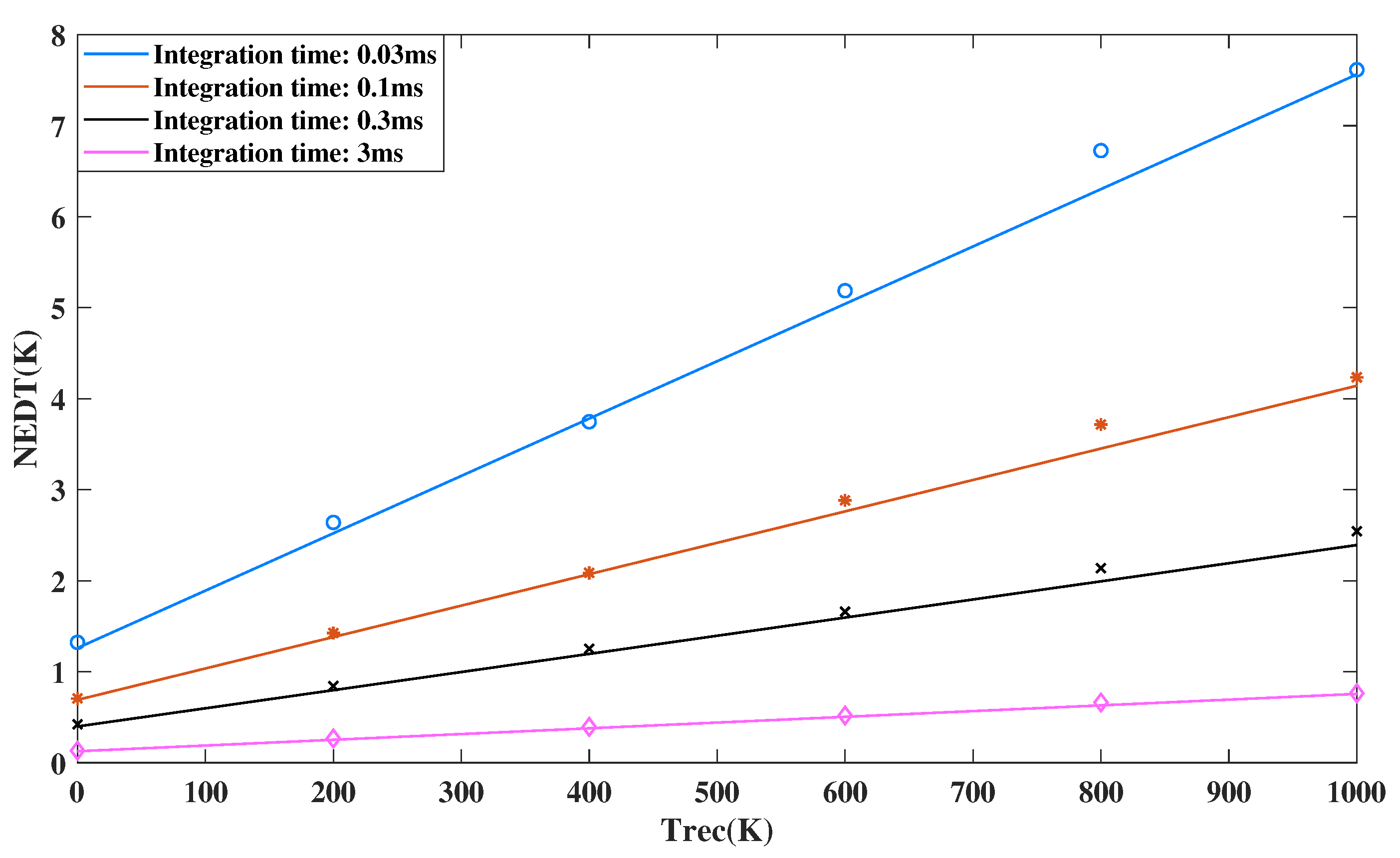
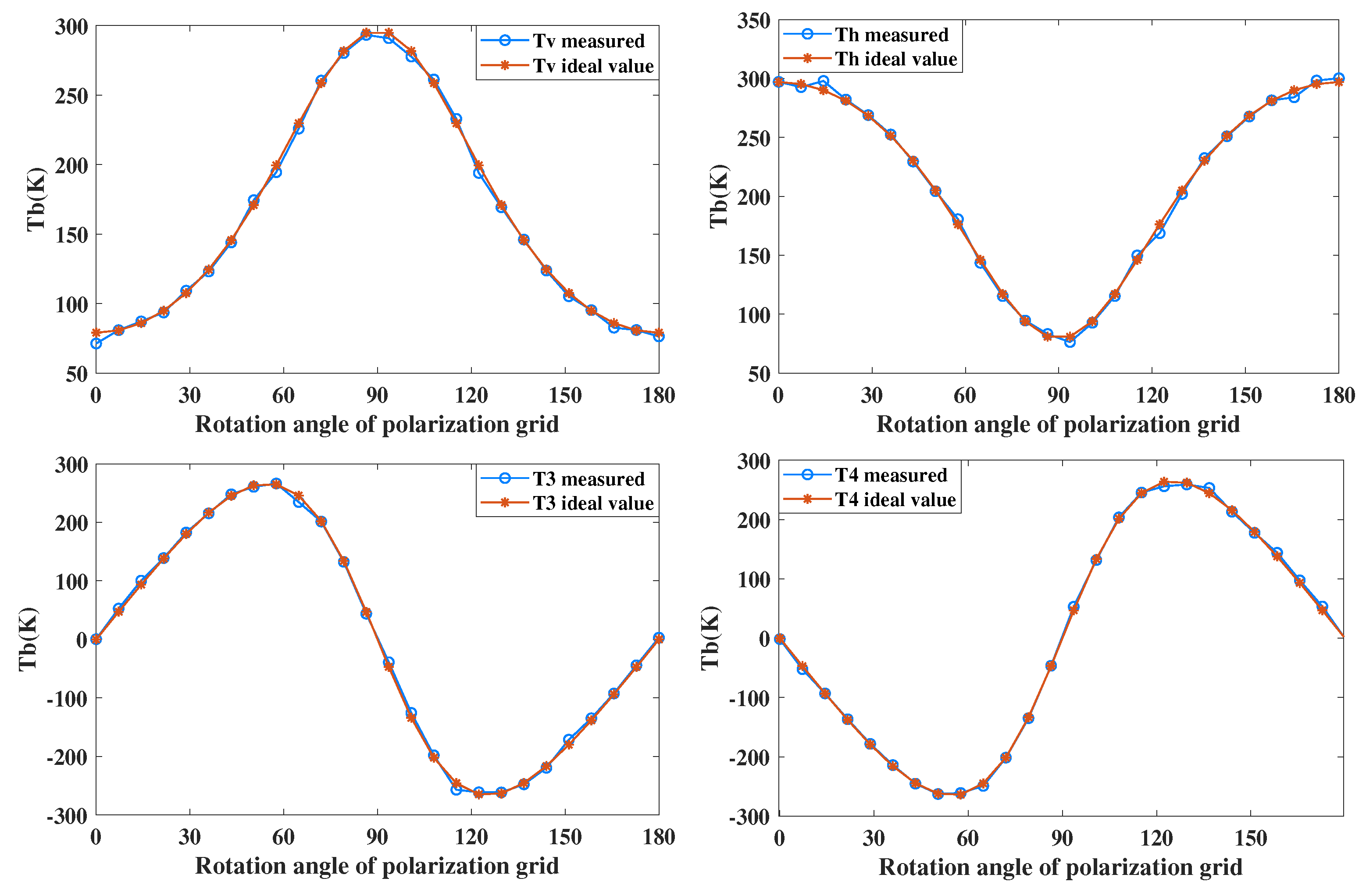
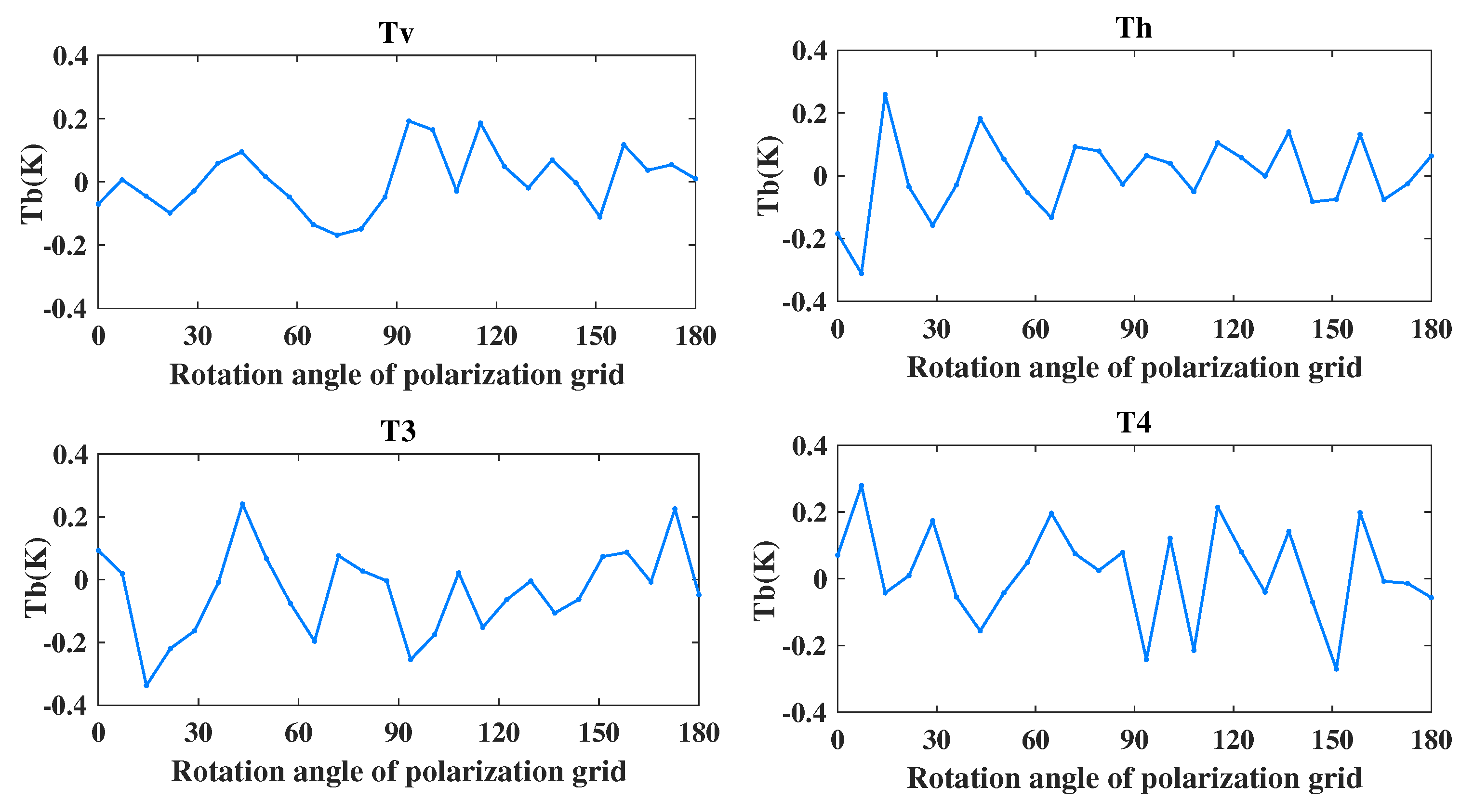
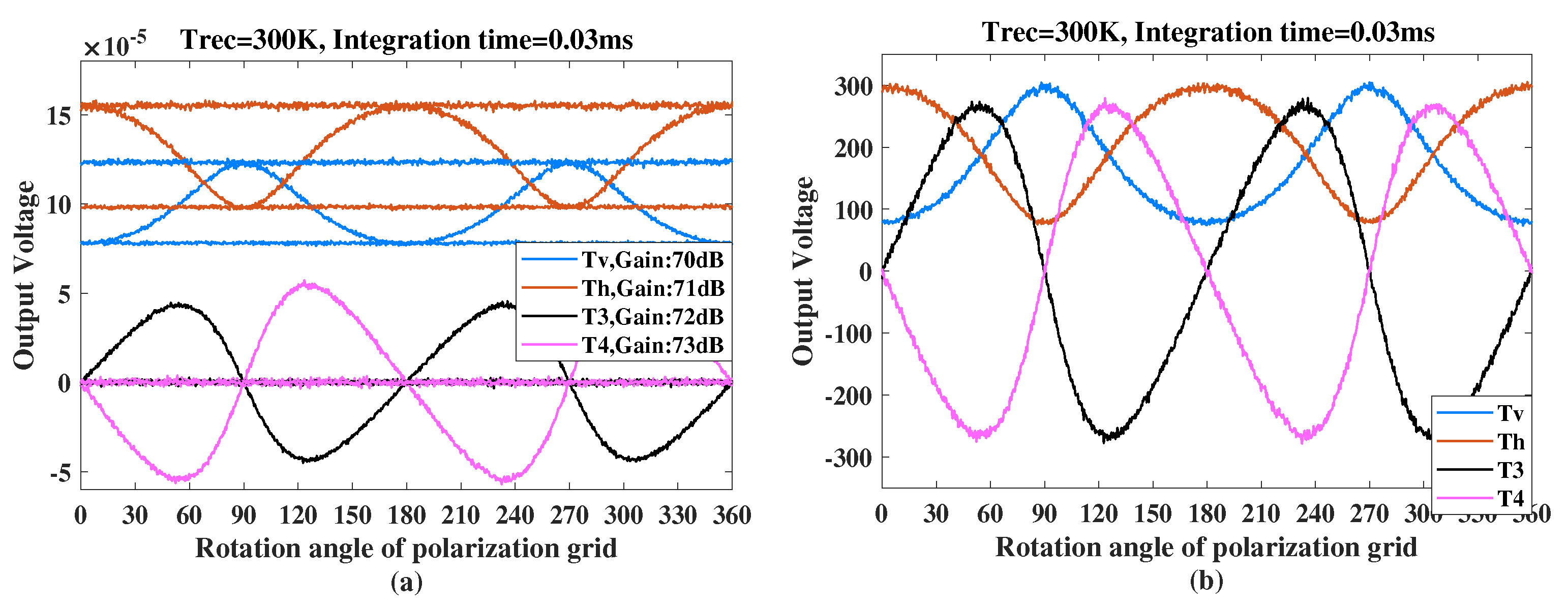
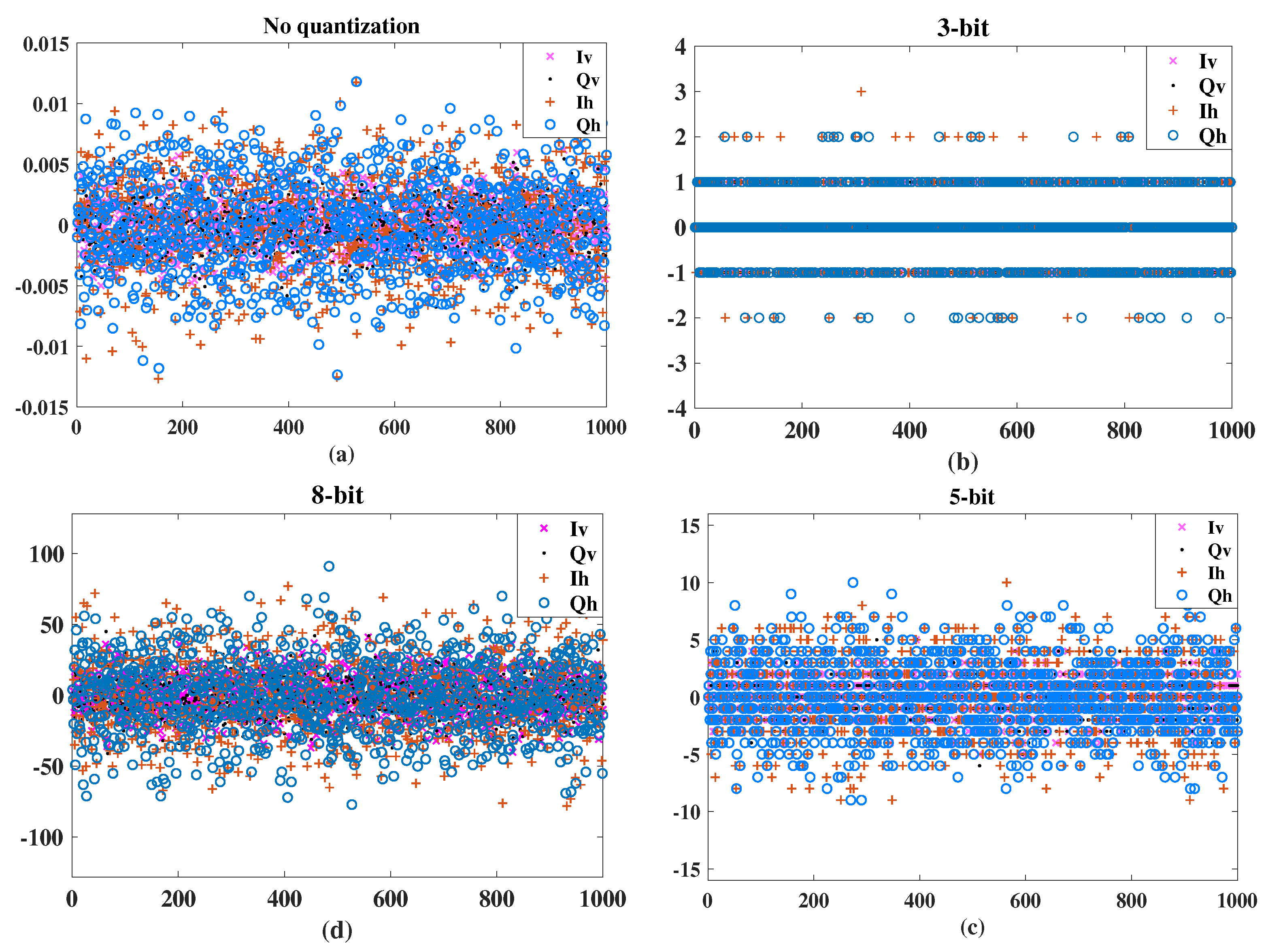
| LO Frequency | Bandwidth | System Noise | Integration Time | Receiver Typ |
|---|---|---|---|---|
| 18.75 GHz | 750 MHz | 300 K | 3 ms | SSB |
| Target Type | Hot Target | Cold Target | Grid Rotation Angle | Delay Phase |
|---|---|---|---|---|
| Fully-polarized | 300 K | 80 K | 0:0.04:2 | −/4 |
| target | 300 K | 80 K | 0:0.04:2 | −7/4 |
| Non-polarized | 300 K | / | Without CPCT system | |
| target | / | 80 K | Without CPCT system |
| Quantization Level | Theoretical Value | Analog | 3-bit | 5-bit | 8-bit |
|---|---|---|---|---|---|
| Sensitivity (K) | 0.1261 | 0.1327 | 0.1404 | 0.1432 | 0.1309 |
Publisher’s Note: MDPI stays neutral with regard to jurisdictional claims in published maps and institutional affiliations. |
© 2021 by the authors. Licensee MDPI, Basel, Switzerland. This article is an open access article distributed under the terms and conditions of the Creative Commons Attribution (CC BY) license (https://creativecommons.org/licenses/by/4.0/).
Share and Cite
Ding, J.; Wang, Z.; Duan, Y.; Tong, X.; Lu, H. A Digital-Simulation Model for a Full-Polarized Microwave Radiometer System and Its Calibration. Remote Sens. 2021, 13, 4888. https://doi.org/10.3390/rs13234888
Ding J, Wang Z, Duan Y, Tong X, Lu H. A Digital-Simulation Model for a Full-Polarized Microwave Radiometer System and Its Calibration. Remote Sensing. 2021; 13(23):4888. https://doi.org/10.3390/rs13234888
Chicago/Turabian StyleDing, Jia, Zhenzhan Wang, Yongqiang Duan, Xiaolin Tong, and Hao Lu. 2021. "A Digital-Simulation Model for a Full-Polarized Microwave Radiometer System and Its Calibration" Remote Sensing 13, no. 23: 4888. https://doi.org/10.3390/rs13234888
APA StyleDing, J., Wang, Z., Duan, Y., Tong, X., & Lu, H. (2021). A Digital-Simulation Model for a Full-Polarized Microwave Radiometer System and Its Calibration. Remote Sensing, 13(23), 4888. https://doi.org/10.3390/rs13234888






